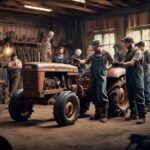Navigating the complexities of vintage engine technology can often feel like deciphering an ancient map—both thrilling and perplexing. Enthusiasts and restorers alike seek the gratification of hearing a classic engine roar to life with renewed vigor, yet the journey to enhanced performance is riddled with obstacles, from outdated components to the enigmatic behavior of physics in older designs. With a landscape filled with such intricacies, finding the path to power and reliability is the quest at the heart of your endeavors.
Drawing on decades of experience with the inner workings of retro engines, our insights serve as your compass, guiding you through the essential modifications and technical refinements that unlock the full potential of these mechanical marvels. Whether you're a seasoned mechanic or a dedicated hobbyist, the tailored strategies we unfold resonate with the spirit of your pursuit.
As we delve into the engines of yesteryear, a shared passion for engineering excellence becomes the foundation of a trusted alliance. Embark on this journey with us, and discover the upgrades and optimizations that will transform your retro engine aspirations into tangible, exhilarating reality.
Continue reading to unravel the expert strategies that promise to steer your vintage engine project toward success.
Key Takeaways
- Integrating an alternative physics engine like Jolt can address geometry-related problems and inaccurate rigid body behavior in older engine models.
- Upgrading the ignition system, carburetor, and exhaust system can significantly improve the performance and reliability of vintage engines.
- Optimizing fuel efficiency in retro engines can be achieved through modern fuel injection systems, fine-tuning ignition timing and air-fuel ratios, and upgrading air intake systems and filters.
- Regular maintenance, such as spark plug replacement, fuel system cleaning, and using high-quality lubricants, is crucial for ensuring optimal fuel efficiency, engine performance, and longevity in retro engines.
Vintage Engine Maintenance: Key Considerations
When considering vintage engine maintenance, it is imperative to assess the specific challenges and limitations inherent in older engine models. The Godot physics engine, although a powerful tool, has notable limitations that necessitate careful attention. Issues such as geometry-related problems and inaccurate rigid body behavior are prevalent challenges that need to be addressed. The need for significant engineering efforts for improvement is evident, and it is crucial to tell us about the engine needs to ensure optimal performance.
Integrating an alternative physics engine like Jolt, specifically designed for AAA games, could be a viable solution to address the limitations of the Godot physics engine. Double precision, particularly for the upcoming Godot 4.0, is of utmost importance, and potential enhancements such as adding doubles to Jolt for the new version should be carefully considered. The development of a stable physics engine is crucial for overcoming the main impediment to developing commercial games with Godot.
Performance Metrics for Retro Engines
Assessing the performance metrics for retro engines is essential for understanding and addressing the specific challenges and limitations inherent in older engine models, as discussed in the previous subtopic.
Monitoring these metrics, such as FPS, memory usage, CPU and GPU utilization, and input latency, is crucial for identifying bottlenecks and areas for optimization in retro engines.
Retro engine developers rely on performance metrics to fine-tune rendering optimization, physics improvements, and AI system enhancements, ultimately leading to a better user experience.
By leveraging these metrics, developers can ensure that retro games maintain authenticity and playability on modern platforms.
The performance metrics act as a guide for developers, allowing them to make informed decisions about where to allocate resources for maximum impact.
This data-driven approach facilitates the enhancement and preservation of classic gaming experiences, aligning with the expectations of enthusiasts who seek to relive and enjoy the nostalgia of retro games.
Essential Upgrades for Vintage Engines
Upgrading vintage engines requires careful consideration of essential components such as the ignition system, carburetor tuning, and exhaust systems.
Upgrading the ignition system can improve engine performance by enhancing spark control and timing precision.
Additionally, fine-tuning the carburetor and installing performance exhaust systems can optimize fuel delivery and exhaust flow, contributing to overall engine efficiency and power output.
Ignition System Upgrade
An essential upgrade for vintage engines involves enhancing the ignition system to improve overall engine performance and reliability. When considering an ignition system upgrade, several key factors should be taken into account:
- Ignition system compatibility: Ensuring that any new ignition components are compatible with the vintage engine is crucial for seamless integration and optimal performance.
- Upgrading vintage coils: Replacing outdated coils with modern, high-energy ignition coils can significantly improve spark energy and combustion efficiency.
- Electronic ignition conversion: Converting from traditional points-based ignition to a modern electronic ignition system can enhance reliability, reduce maintenance, and improve overall engine performance.
These upgrades play a fundamental role in maximizing the reliability, drivability, and efficiency of vintage engines.
Carburetor Tuning Tips
After optimizing the ignition system for improved performance and reliability, attention turns to fine-tuning the carburetor, a critical aspect of enhancing the overall functionality of vintage engines.
Carburetor troubleshooting is essential for identifying and rectifying issues such as erratic idling, stumbling acceleration, or excessive fuel consumption.
A key tip for enhancing engine performance is meticulous fuel mixture adjustment, ensuring the ideal balance of air and fuel for combustion.
Moreover, air intake optimization plays a pivotal role in achieving efficient engine operation. By calibrating the carburetor to match the engine's airflow requirements, optimal performance can be achieved.
It's crucial to methodically assess and adjust the carburetor settings, taking into account factors such as engine load and speed, to achieve the best possible performance from vintage engines.
Performance Exhaust Systems
Enhancing vintage engines with performance exhaust systems entails optimizing the expulsion of exhaust gases for improved power and efficiency. When considering the installation of a performance exhaust system, enthusiasts can benefit from the following:
- Performance exhaust benefits: Upgrading to a performance exhaust system can result in noticeable improvements in horsepower, torque, and fuel efficiency. These systems are designed to reduce back pressure and enhance exhaust scavenging, leading to better overall engine performance.
- Choosing the right exhaust system: It's crucial to select an exhaust system that is specifically designed for the vintage engine model. Factors such as material quality, design, and compatibility should be carefully considered to ensure optimal performance gains.
- Installation tips: Seek professional installation or follow manufacturer guidelines closely to ensure a proper fit and function of the performance exhaust system. Attention to detail during installation can maximize the benefits of the upgrade.
Optimizing Fuel Efficiency in Retro Engines
Addressing the challenge of optimizing fuel efficiency in retro engines requires a comprehensive understanding of the intricate interplay between engine design, combustion dynamics, and energy conversion processes. When it comes to retro engine tuning, factors such as fuel injection advantages and optimizing air intake play a pivotal role in achieving enhanced fuel efficiency. The table below outlines key strategies for optimizing fuel efficiency in retro engines.
| Fuel Efficiency Optimization Strategies | Description |
|---|---|
| Fuel Injection Advantages | Upgrading to modern fuel injection systems can significantly improve fuel atomization and combustion efficiency, leading to better fuel economy and reduced emissions. |
| Retro Engine Tuning | Fine-tuning ignition timing, air-fuel ratios, and carburetor adjustments can maximize the engine's efficiency, resulting in improved fuel economy and overall performance. |
| Optimizing Air Intake | Upgrading air intake systems and filters can enhance airflow, leading to better combustion and improved fuel efficiency. |
| Regular Maintenance | Ensuring regular maintenance of the engine, including spark plug replacement and fuel system cleaning, is essential for optimal fuel efficiency. |
| Aerodynamic Enhancements | Improving the vehicle's aerodynamics through modifications such as adding a rear spoiler or reducing drag can contribute to better fuel efficiency. |
Ignition System Enhancements for Vintage Engines
Enhancing the ignition system of vintage engines involves various key points. These include upgrading spark plugs, tuning the distributor, and optimizing coil performance. These enhancements can significantly improve spark control, fuel efficiency, and overall engine performance.
Aftermarket ignition systems offer adjustable rev limiters and timing curves. This provides vintage engines with modern capabilities for improved drivability and reduced maintenance.
Spark Plug Upgrades
To optimize the performance of vintage engines, one key area of focus lies in the enhancement of the ignition system through spark plug upgrades.
When considering spark plug upgrades for vintage engines, the choice between iridium and platinum plugs is crucial. Both offer exceptional durability and performance, but iridium plugs generally have a finer electrode design, enabling more precise spark and combustion.
Additionally, advanced electrode designs, such as those found in iridium plugs, contribute to improved heat dissipation, which is essential for preventing pre-ignition and detonation in high-performance vintage engines. Therefore, selecting the right spark plug material and electrode design is paramount for maximizing the benefits of the upgrade.
Distributor Tuning
When considering ignition system enhancements for vintage engines, distributor tuning becomes a pivotal focus to further optimize engine performance, building upon the foundation of spark plug upgrades.
Retro engine restoration often involves meticulous timing adjustment, a process where distributor tuning plays a crucial role. Precise timing adjustment through distributor tuning can significantly enhance vintage car performance by ensuring that the ignition system ignites the air-fuel mixture at the most opportune moment during the engine's combustion cycle. This not only improves fuel efficiency but also contributes to overall engine power.
Additionally, distributor tuning addresses common issues such as engine hesitation and rough idling, providing a smoother and more responsive driving experience.
Upgrading the distributor can further refine spark timing precision and ignition coil output, making it an indispensable aspect of maintaining and improving the performance of classic car engines.
Coil Performance Optimization
Coil performance optimization plays a critical role in enhancing the ignition system of vintage engines, leading to improved power output, fuel efficiency, and overall engine performance.
When focusing on ignition coil maintenance, conducting regular coil resistance testing is crucial to identify potential issues and ensure optimal performance.
Additionally, addressing coil overheating issues is essential, as overheating can lead to premature failure and diminished ignition efficiency.
By addressing these key factors, vintage engine enthusiasts can ensure that their ignition systems operate at peak performance, resulting in smoother idling, quicker engine response, better combustion, and reduced emissions.
Ultimately, optimizing the coil performance is a cost-effective method to boost the overall performance of vintage engines.
Cooling System Upgrades for Retro Engines
As the demand for higher performance and efficiency in retro engines continues to grow, the necessity of exploring and implementing cooling system upgrades becomes increasingly apparent.
Cooling system efficiency is crucial for maintaining optimal operating temperatures and preventing overheating in retro engines. Upgrading the radiator to improve heat dissipation is a key consideration in enhancing the cooling system. High-performance radiators with improved fin design and larger surface areas can effectively dissipate heat generated by retro engines, contributing to overall system efficiency.
Additionally, implementing advanced heat dissipation techniques, such as thermal coatings and heat pipes, can further enhance the cooling capabilities of retro engine systems. These upgrades are essential for addressing the thermal challenges associated with older engine designs and can significantly improve the overall performance and reliability of retro engines.
As retro engine enthusiasts continue to seek enhanced capabilities and performance, investing in cooling system upgrades is an integral aspect of achieving these goals.
Enhancing Lubrication in Vintage Engines
The critical importance of maintaining optimal operating temperatures in retro engines extends beyond the cooling system, encompassing the need to enhance lubrication for improved overall engine performance and longevity.
When considering retro engine lubrication, using high-quality, modern lubricants specifically formulated for vintage engines can provide better protection against wear and corrosion. Upgrading to synthetic oils with proper viscosity can help maintain lubrication at varying temperatures, ensuring smoother engine operation. Additionally, implementing regular oil changes and using additives designed for vintage engines can help address lubrication challenges, promoting enhanced engine longevity.
Proper lubrication maintenance is crucial for preventing overheating and reducing friction in vintage engines, ultimately contributing to improved overall performance.




